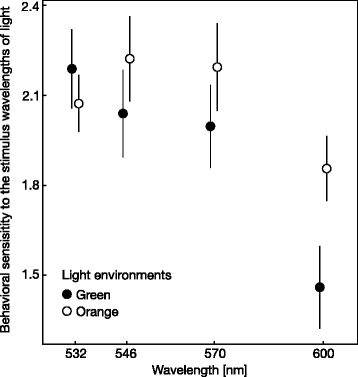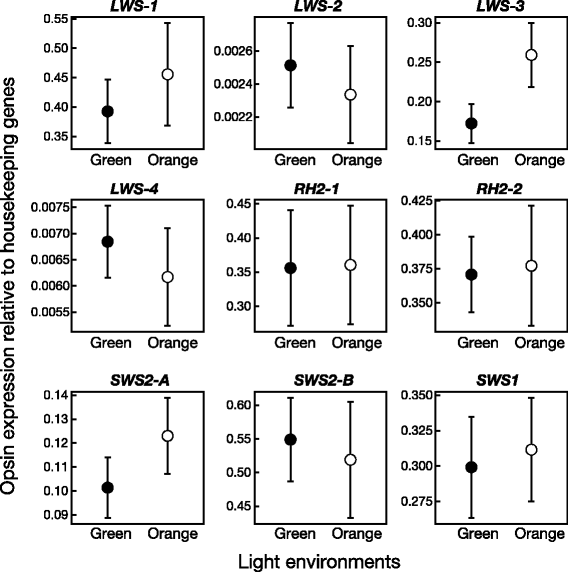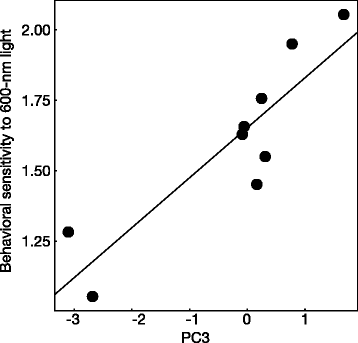Effects of light environment during growth on the expression of cone opsin genes and behavioral spectral sensitivities in guppies (Poecilia reticulata)
- PMID: 27193604
- PMCID: PMC4870739
- DOI: 10.1186/s12862-016-0679-z
Effects of light environment during growth on the expression of cone opsin genes and behavioral spectral sensitivities in guppies (Poecilia reticulata)
Abstract
Background: The visual system is important for animals for mate choice, food acquisition, and predator avoidance. Animals possessing a visual system can sense particular wavelengths of light emanating from objects and their surroundings and perceive their environments by processing information contained in these visual perceptions of light. Visual perception in individuals varies with the absorption spectra of visual pigments and the expression levels of opsin genes, which may be altered according to the light environments. However, which light environments and the mechanism by which they change opsin expression profiles and whether these changes in opsin gene expression can affect light sensitivities are largely unknown. This study determined whether the light environment during growth induced plastic changes in opsin gene expression and behavioral sensitivity to particular wavelengths of light in guppies (Poecilia reticulata).
Results: Individuals grown under orange light exhibited a higher expression of long wavelength-sensitive (LWS) opsin genes and a higher sensitivity to 600-nm light than those grown under green light. In addition, we confirmed that variations in the expression levels of LWS opsin genes were related to the behavioral sensitivities to long wavelengths of light.
Conclusions: The light environment during the growth stage alters the expression levels of LWS opsin genes and behavioral sensitivities to long wavelengths of light in guppies. The plastically enhanced sensitivity to background light due to changes in opsin gene expression can enhance the detection and visibility of predators and foods, thereby affecting survival. Moreover, changes in sensitivities to orange light may lead to changes in the discrimination of orange/red colors of male guppies and might alter female preferences for male color patterns.
Keywords: Color vision; Light environment; Opsin; Sensory drive; Sexual signals.
Figures



Similar articles
-
Genetic and plastic variation in opsin gene expression, light sensitivity, and female response to visual signals in the guppy.Proc Natl Acad Sci U S A. 2018 Nov 27;115(48):12247-12252. doi: 10.1073/pnas.1706730115. Epub 2018 Nov 12. Proc Natl Acad Sci U S A. 2018. PMID: 30420507 Free PMC article.
-
RT-qPCR reveals opsin gene upregulation associated with age and sex in guppies (Poecilia reticulata) - a species with color-based sexual selection and 11 visual-opsin genes.BMC Evol Biol. 2011 Mar 29;11:81. doi: 10.1186/1471-2148-11-81. BMC Evol Biol. 2011. PMID: 21447186 Free PMC article.
-
Spectral sensitivity of guppy visual pigments reconstituted in vitro to resolve association of opsins with cone cell types.Vision Res. 2016 Oct;127:67-73. doi: 10.1016/j.visres.2016.06.013. Epub 2016 Aug 3. Vision Res. 2016. PMID: 27476645
-
Cichlid fish visual systems: mechanisms of spectral tuning.Integr Zool. 2009 Mar;4(1):75-86. doi: 10.1111/j.1749-4877.2008.00137.x. Integr Zool. 2009. PMID: 21392278 Review.
-
Proximate and ultimate causes of variable visual sensitivities: Insights from cichlid fish radiations.Genesis. 2016 Jun;54(6):299-325. doi: 10.1002/dvg.22940. Epub 2016 Apr 25. Genesis. 2016. PMID: 27061347 Free PMC article. Review.
Cited by
-
The sensory impacts of climate change: bathymetric shifts and visually mediated interactions in aquatic species.Proc Biol Sci. 2021 Apr 28;288(1949):20210396. doi: 10.1098/rspb.2021.0396. Epub 2021 Apr 21. Proc Biol Sci. 2021. PMID: 33878924 Free PMC article.
-
Exploring visual plasticity: dietary carotenoids can change color vision in guppies (Poecilia reticulata).J Comp Physiol A Neuroethol Sens Neural Behav Physiol. 2016 Jul;202(7):527-34. doi: 10.1007/s00359-016-1097-9. Epub 2016 Jun 9. J Comp Physiol A Neuroethol Sens Neural Behav Physiol. 2016. PMID: 27283858
-
Genetic and plastic variation in opsin gene expression, light sensitivity, and female response to visual signals in the guppy.Proc Natl Acad Sci U S A. 2018 Nov 27;115(48):12247-12252. doi: 10.1073/pnas.1706730115. Epub 2018 Nov 12. Proc Natl Acad Sci U S A. 2018. PMID: 30420507 Free PMC article.
-
Geographic variation in opsin expression does not align with opsin genotype in Lake Victoria cichlid populations.Ecol Evol. 2019 Jul 9;9(15):8676-8689. doi: 10.1002/ece3.5411. eCollection 2019 Aug. Ecol Evol. 2019. PMID: 31410271 Free PMC article.
-
Opsin gene expression regulated by testosterone level in a sexually dimorphic lizard.Sci Rep. 2018 Oct 30;8(1):16055. doi: 10.1038/s41598-018-34284-z. Sci Rep. 2018. PMID: 30375514 Free PMC article.
References
-
- Endler JA. Signals, signal conditions, and the direction of evolution. Am Nat. 1992;139:S125–S153. doi: 10.1086/285308. - DOI
MeSH terms
Substances
Associated data
LinkOut - more resources
Full Text Sources
Other Literature Sources

